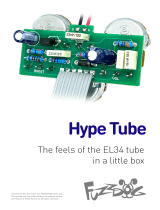Page is loading ...

Freek Fuzz
Boutique take on the
Regulus VIII Os Mutantes Fuzz
Contents of this document are ©2022 Pedal Parts Ltd.
No reproduction permitted without the express written
permission of Pedal Parts Ltd. All rights reserved.

Important notes
If you’re using any of our footswitch daughterboards,
DOWNLOAD THE DAUGHTERBOARD DOCUMENT
•Download and read the appropriate build document for the daughterboard
as well as this one BEFORE you start.
•DO NOT solder the supplied Current Limiting Resistor (CLR) to the main
circuit board even if there is a place for it. This should be soldered to the
footswitch daughterboard.
POWER SUPPLY
Unless otherwise stated in this document this circuit is designed to be
powered with 9V DC.
COMPONENT SPECS
Unless otherwise stated in this document:
•Resistors should be 0.25W. You can use those with higher ratings but
check the physical size of them.
•Electrolytics caps should be at least 25V for 9V circuits, 35V for 18V
circuits. Again, check physical size if using higher ratings.
LAYOUT CONVENTIONS
Unless otherwise stated in this document, the following are used:
•Electrolytic capacitors:
Long leg (anode) to square pad.
•Diodes/LEDs:
Striped leg (cathode) to square pad. Short leg to square pad for LEDs.
•ICs:
Square pad indicates pin 1.

Schematic + BOM
R1 2K2
R2 3M3
R3 2K7
R4 1M2
R5 4K7 / 10K Trim*
R6 22K
R7 470K
R8 100K
R9 12K
R10 2K7
C1 4n7
C2 1u
C3 4n7
C4 100n
C5 10u elec
C6 10u elec
C7 470p
C8 100n
C9 100u elec
D1 1N5817
D2-3 1N4148
Q1-3 BC549B**
FUZZ 100KA
CLAMP 1KB
SAT 100KB
VOL 100KA
*R5 is a fixed 4K7 resistor in the original, but the circuit benefits from some
tweaking of the Q2 bias. We recommend putting a 10K trimmer in here, positioned
in the centre of the turn. Give it little tweaks either way until you get the best
results. There’s no right or wrong.
**Feel free to use other BJTs for Q1-3, but watch your pinout. The board is
designed for BC549B which have the reverse pinout to others such as 2N5088,
2N3904 etc, so you’ll need to reverse those if you want to play around.


PCB layout ©2022 Pedal Parts Ltd.
The power and signal pads on the PCB conform
to the FuzzDog Direct Connection format, so can
be paired with the appropriate daughterboard for
quick and easy offboard wiring. Check the
separate daughterboard document for details.
Be very careful when soldering the diodes and
transistors. They’re very sensitive to heat. You
should use some kind of heat sink (crocodile clip
or reverse action tweezers) on each leg as you
solder them. Keep exposure to heat to a
minimum (under 2 seconds).
Snap the small metal tag off the pots so they can
be mounted flush in the box.
You should solder all other board-mounted
components before you solder the pots. Once
they’re in place you’ll have no access to much of
the board. Make sure your pots all line up nicely.
The best way to do that is to solder
a single pin of each pot in place then melt and
adjust if necessary before soldering in the other
two pins. If your pots don’t have protective
plastic jackets ensure you leave a decent gap
between the pot body and the PCB otherwise
you risk shorting out the circuit.
There are extra pads for the trimmer. They are
connected within the PCB traces as shown in
red above. As long as one pin of your trimmer
goes in each row you’re good. If you want to use
a fixed resistor for R5 place it upright with the
legs going into pads A and B.
A
B

Test the board!
Check the relevant daughterboard document for more
info before you undertake this stage.
UNDER NO CIRCUMSTANCES will troubleshooting help
be offered if you have skipped this stage. No exceptions.
Once you’ve finished the circuit it makes sense to test is before starting on the switch and LED
wiring. It’ll cut down troubleshooting time in the long run. If the circuit works at this stage, but it
doesn’t once you wire up the switch - guess what? You’ve probably made a mistake with the switch.
Solder some nice, long lengths of wire to the board connections for 9V, GND, IN and OUT. Connect
IN and OUT to the jacks as shown. Connect all the GNDs together (twist them up and add a small
amount of solder to tack it). Connect the battery + lead to the 9V wire, same method. Plug in. Go!
If you’re using a ribbon cable you can tack the wires to the ends of that. It’s a lot easier to take them
off there than it is do desolder wires from the PCB pads.
If it works, carry on and do your switch wiring. If not... aw man. At least you know the problem is
with the circuit. Find out why, get it working, THEN worry about the switch etc.
Your completed circuit board
including pots

Now’s the time
to refer to the
daughterboard
document for
your chosen
bypass method.
Enjoy your pedal!

This template is a rough guide only. You should ensure correct marking of your
enclosure before drilling. You use this template at your own risk.
Pedal Parts Ltd can accept no responsibility for incorrect drilling of enclosures.
FuzzDog.co.uk
Recommended drill sizes:
Pots 7mm
Jacks 10mm
Footswitch 12mm
DC Socket 12mm
Toggle switches 6mm
32mm
Drilling template
without battery
Hammond 1590B - 60 x 111 x 31mm
It’s a good idea to drill the pot and
toggle switch holes 1mm bigger if
you’re board-mounting them.
Wiggle room = good!
27mm
/












